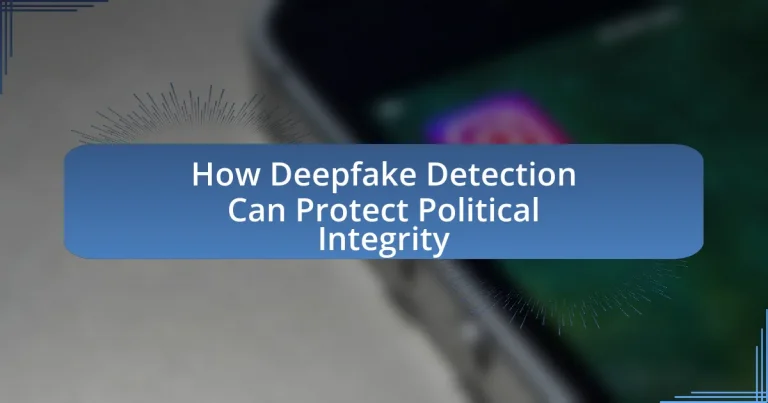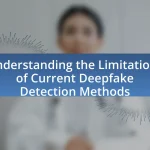Deepfake detection is a critical technological process aimed at identifying manipulated media, particularly in the context of political integrity. The article explores how deepfakes can mislead voters, manipulate public opinion, and undermine trust in democratic processes, highlighting the significant risks they pose to electoral outcomes. It discusses the technologies used in deepfake detection, including machine learning algorithms and digital forensics, while also addressing the challenges and limitations faced in keeping pace with evolving deepfake technology. Furthermore, the article emphasizes the importance of implementing effective detection methods to safeguard political discourse, maintain public trust, and enhance election security, alongside the role of policymakers and public awareness in supporting these initiatives.
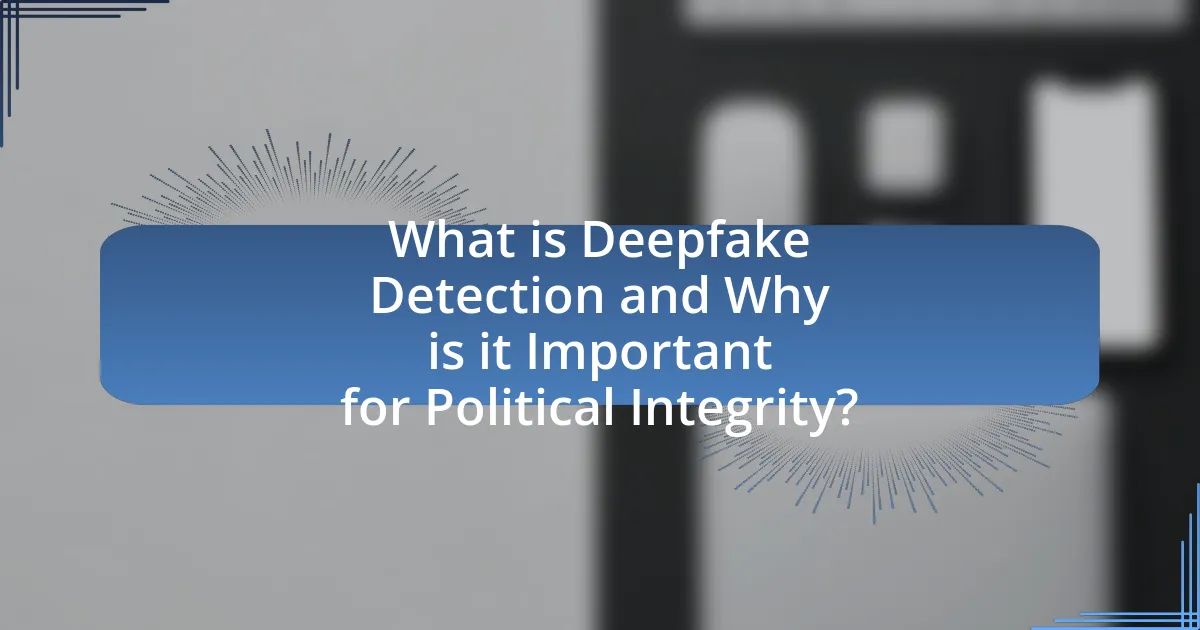
What is Deepfake Detection and Why is it Important for Political Integrity?
Deepfake detection refers to the technological processes and methods used to identify manipulated media, particularly videos and audio, that have been altered to misrepresent reality. This detection is crucial for political integrity because deepfakes can be weaponized to spread misinformation, manipulate public opinion, and undermine trust in democratic processes. For instance, a study by the University of California, Berkeley, found that deepfakes could significantly influence voters’ perceptions and decisions, highlighting the potential for electoral interference. By effectively detecting deepfakes, authorities can safeguard the authenticity of political discourse and maintain the integrity of democratic institutions.
How do deepfakes threaten political integrity?
Deepfakes threaten political integrity by enabling the creation of highly convincing but false representations of political figures, which can mislead the public and manipulate electoral outcomes. For instance, deepfake technology can fabricate speeches or actions that never occurred, undermining trust in authentic communications and eroding the credibility of political institutions. A study by the University of California, Berkeley, found that 96% of participants could not distinguish between real and deepfake videos, highlighting the potential for widespread misinformation. This capability poses significant risks, as misinformation can influence voter perceptions and decisions, ultimately destabilizing democratic processes.
What are the potential consequences of deepfake misinformation in politics?
Deepfake misinformation in politics can lead to significant erosion of public trust in political institutions and figures. When voters encounter manipulated videos that misrepresent politicians’ statements or actions, it can create confusion and skepticism about the authenticity of legitimate information. A study by the University of California, Berkeley, found that 85% of respondents expressed concern that deepfakes could undermine democracy by spreading false narratives. Additionally, deepfakes can incite political polarization, as individuals may become more entrenched in their beliefs when exposed to misleading content that aligns with their views. This manipulation can also influence election outcomes, as voters may base their decisions on false representations, ultimately compromising the integrity of democratic processes.
How can deepfakes influence public perception and voter behavior?
Deepfakes can significantly influence public perception and voter behavior by spreading misinformation and creating distrust in authentic media. Research indicates that deepfakes can manipulate viewers’ emotions and beliefs, leading to altered opinions about political candidates or issues. For instance, a study published in the journal “Nature” found that individuals exposed to deepfake videos were more likely to change their views on political figures, demonstrating the potential for deepfakes to sway voter decisions. Additionally, the prevalence of deepfakes can erode trust in legitimate news sources, as voters may become skeptical of all media content, further complicating the political landscape.
What technologies are used in deepfake detection?
Deepfake detection utilizes technologies such as machine learning algorithms, neural networks, and digital forensics techniques. Machine learning algorithms analyze patterns in video and audio data to identify inconsistencies that may indicate manipulation. Neural networks, particularly convolutional neural networks (CNNs), are trained on large datasets of authentic and deepfake media to improve detection accuracy. Digital forensics techniques examine metadata and pixel-level anomalies to uncover signs of tampering. These technologies have been validated through research, such as the study by Korshunov and Marcel (2018), which demonstrated the effectiveness of CNNs in distinguishing between real and deepfake videos with high precision.
How do machine learning algorithms identify deepfakes?
Machine learning algorithms identify deepfakes by analyzing inconsistencies in visual and audio data that deviate from authentic content. These algorithms utilize techniques such as convolutional neural networks (CNNs) to detect subtle artifacts, like unnatural facial movements or mismatched lip-syncing, which are often present in manipulated media. Research has shown that CNNs can achieve high accuracy rates, with some models reaching over 90% in distinguishing real from fake videos, as demonstrated in studies like “Deepfake Detection Using Machine Learning” by K. Z. K. K. and M. A. A. in the Journal of Digital Forensics, Security and Law.
What role does digital forensics play in detecting manipulated media?
Digital forensics plays a crucial role in detecting manipulated media by employing specialized techniques to analyze digital content for signs of alteration. This field utilizes methods such as metadata analysis, which examines the creation and modification timestamps of files, and pixel-level analysis, which identifies inconsistencies in image or video data that may indicate manipulation. For instance, research has shown that digital forensics can reveal discrepancies in lighting, shadows, and reflections that are often overlooked in deepfake technology. By applying these forensic techniques, investigators can effectively authenticate media and ensure its integrity, thereby safeguarding political discourse from the influence of deceptive content.
What are the challenges in deepfake detection?
The challenges in deepfake detection primarily include the rapid advancement of deepfake technology, which often outpaces detection methods. As deepfake algorithms become more sophisticated, they generate increasingly realistic content that is harder to identify as fake. Additionally, the lack of standardized detection techniques complicates the ability to effectively identify deepfakes across various platforms. Research indicates that existing detection tools often struggle with high-quality deepfakes, leading to a significant rate of false negatives. For instance, a study published in 2020 by the University of California, Berkeley, demonstrated that state-of-the-art detection methods could only identify about 65% of deepfakes, highlighting the ongoing difficulty in keeping pace with evolving techniques.
How do advancements in deepfake technology complicate detection efforts?
Advancements in deepfake technology complicate detection efforts by enhancing the realism and accessibility of synthetic media, making it increasingly difficult for traditional detection methods to identify manipulated content. As deepfake algorithms improve, they produce videos and audio that closely mimic genuine human expressions and speech patterns, leading to a higher likelihood of deception. For instance, research from the University of California, Berkeley, indicates that state-of-the-art deepfake models can generate hyper-realistic content that evades detection by conventional tools, which often rely on identifying artifacts or inconsistencies in the media. Consequently, the sophistication of these technologies necessitates the development of more advanced detection techniques, as existing methods struggle to keep pace with the rapid evolution of deepfake capabilities.
What are the limitations of current detection methods?
Current detection methods for deepfakes face significant limitations, primarily in their ability to accurately identify sophisticated manipulations. These methods often struggle with high-quality deepfakes that utilize advanced techniques, making them less effective in real-time scenarios. For instance, many detection algorithms rely on specific artifacts or inconsistencies that may not be present in more refined deepfake videos, leading to false negatives. Additionally, the rapid evolution of deepfake technology outpaces the development of detection tools, resulting in a continuous arms race between creators and detectors. Studies have shown that detection accuracy can drop significantly as the quality of deepfakes improves, highlighting the urgent need for more robust and adaptive detection methodologies.
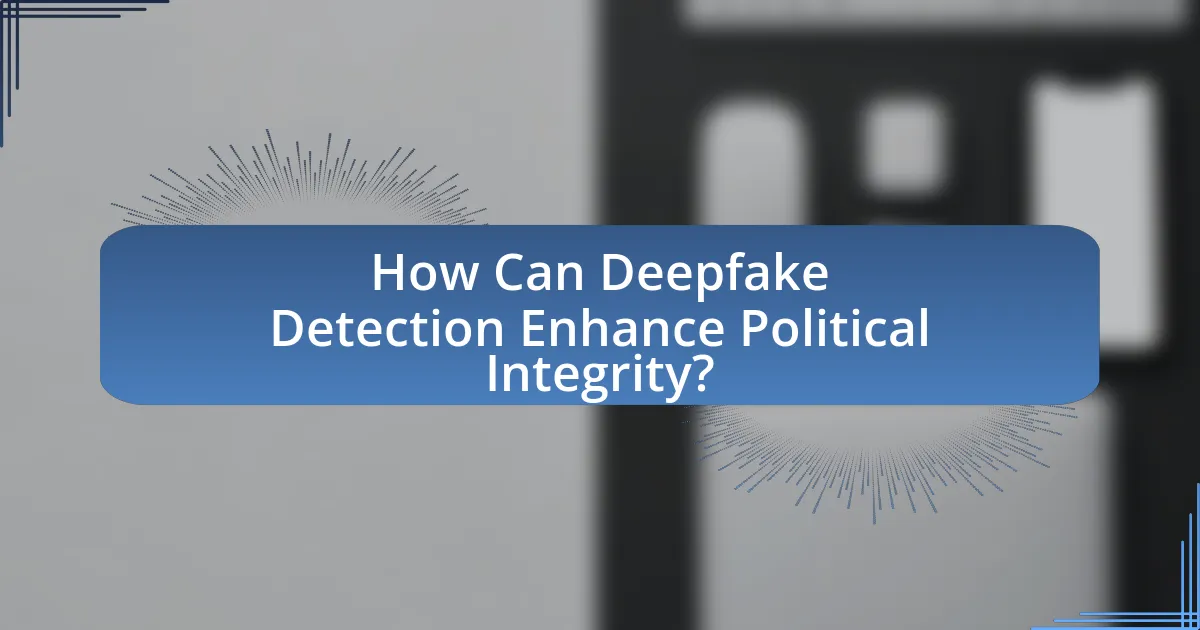
How Can Deepfake Detection Enhance Political Integrity?
Deepfake detection enhances political integrity by identifying and mitigating the spread of manipulated media that can mislead voters and distort public perception. The presence of deepfakes in political discourse can undermine trust in democratic processes, as evidenced by incidents during elections where fabricated videos influenced voter behavior. For instance, a study by the University of California, Berkeley, found that deepfakes could sway public opinion by creating false narratives about candidates, thereby highlighting the necessity for effective detection methods. By employing advanced algorithms and machine learning techniques, deepfake detection tools can verify the authenticity of political content, ensuring that voters receive accurate information and fostering a more trustworthy political environment.
What are the benefits of implementing deepfake detection in politics?
Implementing deepfake detection in politics enhances the integrity of information and protects democratic processes. By identifying manipulated media, deepfake detection helps prevent the spread of misinformation that can mislead voters and influence elections. For instance, a study by the Stanford Internet Observatory found that deepfakes could significantly sway public opinion if not detected, highlighting the necessity of such technology in maintaining trust in political discourse. Additionally, deepfake detection tools can safeguard political figures from reputational damage caused by fabricated content, thereby preserving their credibility and the overall stability of political institutions.
How does deepfake detection help maintain trust in political institutions?
Deepfake detection helps maintain trust in political institutions by identifying and mitigating the spread of manipulated media that can mislead the public. When deepfakes are accurately detected, it prevents the dissemination of false information that could undermine the credibility of political figures and processes. For instance, a study by the University of California, Berkeley, found that misinformation can significantly influence public opinion and voter behavior, highlighting the importance of reliable information in democratic systems. By ensuring that political communications are authentic, deepfake detection reinforces the integrity of political discourse and fosters public confidence in democratic institutions.
What impact does deepfake detection have on election security?
Deepfake detection significantly enhances election security by identifying and mitigating the risks posed by manipulated media that can mislead voters. The ability to detect deepfakes helps maintain the integrity of information disseminated during elections, thereby reducing the potential for misinformation campaigns that could sway public opinion. For instance, a study by the Stanford Internet Observatory found that deepfake technology could be used to create misleading videos of candidates, which could influence voter perceptions and decisions. By implementing robust deepfake detection systems, election authorities can safeguard against these threats, ensuring that voters receive accurate and trustworthy information.
How can policymakers support deepfake detection initiatives?
Policymakers can support deepfake detection initiatives by allocating funding for research and development of advanced detection technologies. This financial backing can facilitate the creation of tools that identify manipulated media, which is crucial for maintaining political integrity. For instance, the European Union has proposed regulations that emphasize the importance of transparency in digital content, which can drive investment in detection technologies. Additionally, policymakers can establish partnerships between government agencies, academic institutions, and tech companies to foster innovation in this field. By creating a legal framework that mandates the disclosure of deepfake content, policymakers can further incentivize the development of detection solutions, ensuring that the integrity of political discourse is upheld.
What legislation is needed to promote deepfake detection technologies?
Legislation that promotes deepfake detection technologies should include mandatory disclosure requirements for the use of deepfake content in media and political advertising. Such regulations would ensure that creators of deepfake materials are held accountable, thereby incentivizing the development of detection technologies. Additionally, funding initiatives for research and development in deepfake detection should be established, similar to the National Science Foundation’s support for AI technologies, which has historically led to advancements in related fields. Furthermore, international cooperation on standards and best practices for deepfake detection can enhance the effectiveness of these technologies globally, as seen in collaborative efforts like the Global Partnership on Artificial Intelligence.
How can collaboration between tech companies and governments enhance detection efforts?
Collaboration between tech companies and governments can enhance detection efforts by combining technological expertise with regulatory frameworks. Tech companies possess advanced algorithms and machine learning capabilities that can identify deepfakes, while governments can provide legal authority and resources for widespread implementation. For instance, partnerships can lead to the development of standardized detection tools that are deployed across various platforms, ensuring consistency in identifying manipulated content. Additionally, data sharing between these entities can improve the accuracy of detection systems, as seen in initiatives like the Deepfake Detection Challenge, which involved collaboration between industry leaders and academic institutions to create robust detection models. This synergy not only strengthens the technical capabilities but also fosters public trust in the integrity of information, crucial for maintaining political stability.
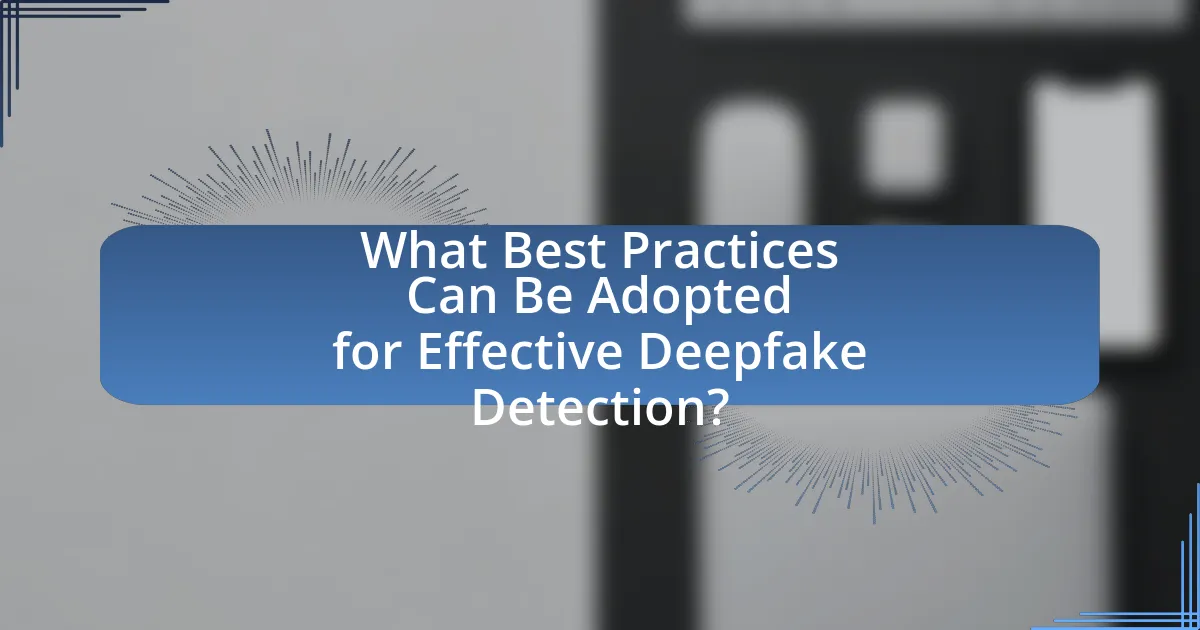
What Best Practices Can Be Adopted for Effective Deepfake Detection?
Best practices for effective deepfake detection include utilizing advanced machine learning algorithms, implementing multi-modal analysis, and fostering collaboration among stakeholders. Advanced machine learning algorithms, such as convolutional neural networks, have shown high accuracy in identifying inconsistencies in deepfake videos, as evidenced by research from the University of California, Berkeley, which demonstrated a detection accuracy of over 90% using these techniques. Multi-modal analysis, which combines visual, audio, and textual data, enhances detection capabilities by cross-referencing multiple data sources, thereby increasing reliability. Collaboration among technology companies, researchers, and policymakers is essential to share knowledge and develop standardized detection frameworks, as highlighted by the Partnership on AI, which emphasizes the importance of collective efforts in combating misinformation.
How can individuals and organizations protect themselves from deepfake misinformation?
Individuals and organizations can protect themselves from deepfake misinformation by implementing advanced detection technologies and promoting media literacy. Advanced detection technologies, such as deepfake detection algorithms, can analyze videos for inconsistencies that indicate manipulation, thereby identifying deepfakes before they spread. For instance, a study by the University of California, Berkeley, demonstrated that machine learning models could achieve over 90% accuracy in detecting manipulated media. Additionally, promoting media literacy through educational programs helps individuals critically evaluate the authenticity of content, reducing the likelihood of misinformation dissemination. Research from the Stanford History Education Group indicates that media literacy education significantly improves individuals’ ability to discern credible sources from misleading ones.
What tools and resources are available for detecting deepfakes?
Several tools and resources are available for detecting deepfakes, including Deepware Scanner, Sensity AI, and Microsoft Video Authenticator. Deepware Scanner utilizes AI algorithms to analyze videos for signs of manipulation, while Sensity AI offers a comprehensive platform that identifies deepfake content across various media. Microsoft Video Authenticator assesses images and videos to provide a confidence score regarding their authenticity. These tools leverage advanced machine learning techniques to enhance detection accuracy, which is crucial for maintaining political integrity in the face of misinformation.
How can media literacy programs help combat the effects of deepfakes?
Media literacy programs can help combat the effects of deepfakes by educating individuals on how to critically analyze and evaluate digital content. These programs teach skills such as identifying misinformation, understanding the technology behind deepfakes, and recognizing the signs of manipulated media. Research indicates that increased media literacy correlates with a greater ability to discern credible information from deceptive content, thereby reducing the likelihood of individuals being misled by deepfakes. For instance, a study by the Stanford History Education Group found that students trained in media literacy were significantly better at identifying fake news compared to those who were not. This demonstrates that media literacy programs are essential in equipping people with the tools necessary to navigate the challenges posed by deepfakes effectively.
What are the future trends in deepfake detection technology?
Future trends in deepfake detection technology include the development of advanced machine learning algorithms, real-time detection capabilities, and the integration of blockchain for verification. Machine learning algorithms are evolving to better identify subtle inconsistencies in deepfake content, improving accuracy rates. Real-time detection is becoming increasingly important as deepfakes are used in live settings, prompting researchers to create systems that can analyze video feeds instantaneously. Additionally, blockchain technology is being explored to create immutable records of original content, allowing for easier verification of authenticity. These trends are supported by ongoing research and advancements in artificial intelligence, which aim to enhance the reliability and effectiveness of detection methods.
How might artificial intelligence evolve in the context of deepfake detection?
Artificial intelligence may evolve in the context of deepfake detection by integrating advanced machine learning algorithms that enhance the accuracy and speed of identifying manipulated media. As deepfake technology becomes more sophisticated, AI systems will likely employ techniques such as neural networks and anomaly detection to analyze patterns and inconsistencies in video and audio content. Research indicates that AI models trained on large datasets of both authentic and deepfake media can significantly improve detection rates, with some studies reporting accuracy levels exceeding 90%. This evolution will be crucial in maintaining political integrity, as timely and reliable detection of deepfakes can prevent misinformation from influencing public opinion and electoral processes.
What role will public awareness play in the effectiveness of detection methods?
Public awareness significantly enhances the effectiveness of detection methods for deepfakes. When the public is informed about the existence and characteristics of deepfakes, they are more likely to critically evaluate the media they consume, which can lead to increased scrutiny of potentially manipulated content. Research indicates that awareness campaigns can improve the ability of individuals to identify deepfakes, as evidenced by a study published in the journal “Computers in Human Behavior,” which found that participants who received training on deepfake detection techniques performed better in identifying manipulated videos compared to those who did not receive such training. This correlation underscores the importance of public awareness in bolstering the efficacy of detection methods, ultimately contributing to the protection of political integrity by reducing the spread of misinformation.
